Corel Paint Shop Pro Photo X2: Easier and Less Expensive
If you're a graphics or design professional, you probably use Adobe Photoshop when you need to modify photographic images, whether they originated in a film camera or a digital camera. Those who don't have the budget to buy the full version of Photoshop often buy Photoshop Elements, but there are good reasons for choosing Corel's Paint Shop Pro Photo X2 instead.
What's with the name, though? Paint Shop Pro was developed in Minnesota by Jasc. I always considered it to be the best bargain in digital photo editors. Then Corel acquired it and the name got longer. Corel Paint Shop Pro. Corel Paint Shop Pro Photo. Corel Paint Shop Pro Photo X2. It's getting harder to fit the name on the box. The X2 version has been out for a while and I've been slow to review it. I can't blame that on the length of the name, though.
Digital image editors can take one of two approaches: One is to create complex tools that give the user extremely fine grained controls. This is the approach chosen by Adobe for Photoshop. The menus are deep and the controls are complex. But if you're a professional who needs precision control, this is the way to go. Photoshop Elements and PSP X2 take another approach—one that doesn't offer the precision, but that allow a user to improve an image with just a few clicks. True, you don't have the precise control the Photoshop provides, but you also don't have to spend a year learning the intricacies.
This isn't a head-to-head review with the Adobe products because that would be unfair to both. It is a description of how PSP X2 works and an explanation of why it might be the best choice for you.
![]() PSP X2 includes features that rival those found in much more expensive programs and the interface makes the program relatively easy to use without insulting the user's intelligence. PSP X2 offers layers and this is a feature everyone who needs to modify digital images should take the time to learn. In addition to the standard tools, there are some that could be classified as silly (but fun) and the support for digital raw formats is limited. For example, I own a Nikon that PSP X2 supports, but the raw format of images from Fuji camera that I use for some projects isn't yet supported.
PSP X2 includes features that rival those found in much more expensive programs and the interface makes the program relatively easy to use without insulting the user's intelligence. PSP X2 offers layers and this is a feature everyone who needs to modify digital images should take the time to learn. In addition to the standard tools, there are some that could be classified as silly (but fun) and the support for digital raw formats is limited. For example, I own a Nikon that PSP X2 supports, but the raw format of images from Fuji camera that I use for some projects isn't yet supported.
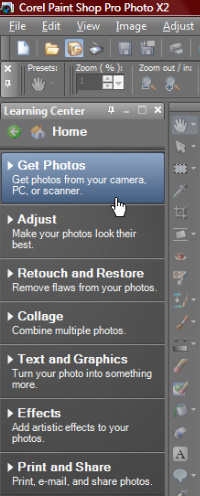 PSP X2 combines photo editing, retouching, painting, drawing, and image management into one package and Corel's Learning Center and training videos make learning how to make the most of the program relatively painless. At the left you see some of the quick options.
PSP X2 combines photo editing, retouching, painting, drawing, and image management into one package and Corel's Learning Center and training videos make learning how to make the most of the program relatively painless. At the left you see some of the quick options.
I've always liked and respected Paint Shop the the acquisition by Corel has helped the application grow well beyond its shareware roots. Some of the features that are new to the X2 version include Express Lab (quick fixes for common problems), HDR Photo Merge (allows combining bracketed shots to create an image in which bright and dark areas both retain detail), Layers Styles (shadows, reflections, inner/outer glows, bevels, and embossing effects), and Makeover Tools (to make people look thinner or thicker, fixing bloodshot eyes, removing blemishes, and the like.)
PSP X2 has a new color scheme called the Graphite Workspace that provides a more neutral setting for working on your images. If you're concerned about someone stealing your images, PSP X2 can apply a visible watermark. By default, PSP X2 preserves original images so that you can always go back to the original. This solves a problem that has been the bane of digital editing from day one.
A real life example
I've been taking pictures at a construction site in conditions that are, at best, challenging. Accurate (or believable) color depends on the color of the light and mixed-light color sources are extremely difficult to get right. At the construction site, there are windows (the light is a high-temperature blue) and incandescent lights (low-temperature red). Making the situation worse, there are fluorescent lights (which are heavy in green and largely without any red component). No matter what I do, the resulting image won't be great.
![]()
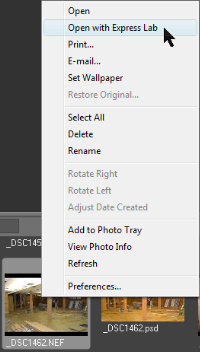 I started with the thumbnail view. PSP X2 allows me to change the size of the thumbnail image by moving the adjustment show here to the left (smaller) or right (larger). Then, once I've selected an image, I can right-click it and open it in the Express Lab. This is essentially the equivalent of opening file in Image Raw in Photoshop.
I started with the thumbnail view. PSP X2 allows me to change the size of the thumbnail image by moving the adjustment show here to the left (smaller) or right (larger). Then, once I've selected an image, I can right-click it and open it in the Express Lab. This is essentially the equivalent of opening file in Image Raw in Photoshop.
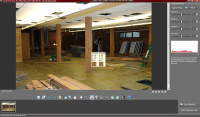 So here's what I'm starting with. There are workers in the background, but they're largely lost in the shadows. The image has an overall green cast from the fluorescent lighting. And the windows are adding a cloudy winter afternoon blue cast to the overall image. This is not a winner as it stands.
So here's what I'm starting with. There are workers in the background, but they're largely lost in the shadows. The image has an overall green cast from the fluorescent lighting. And the windows are adding a cloudy winter afternoon blue cast to the overall image. This is not a winner as it stands.
 The first thing I tried was the automatic image repair. As you can see, it's better than the original, but this image has so many problems that it really needs some manual adjustment.
The first thing I tried was the automatic image repair. As you can see, it's better than the original, but this image has so many problems that it really needs some manual adjustment.
 I've now made some manual adjustments (see the sliders at the right of the image). You don't have as many options available here as you would with Adobe Photoshop, but unless you're a professional who understands all of the controls that Photoshop provides, the controls offered by PSP X2 should be adequate. This image lacks contrast, but the workers in the background are now visible.
I've now made some manual adjustments (see the sliders at the right of the image). You don't have as many options available here as you would with Adobe Photoshop, but unless you're a professional who understands all of the controls that Photoshop provides, the controls offered by PSP X2 should be adequate. This image lacks contrast, but the workers in the background are now visible.
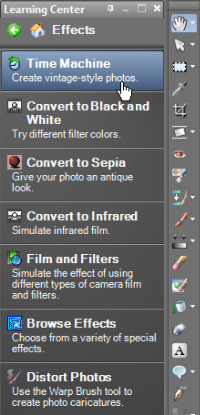
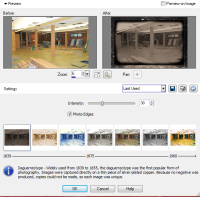 At this point, I thought I'd take a look at the Time Machine effects. These apply color balance effects that approximate photographs from the mid 1800s through the 1960s. At the left you'll see a Daguerreotype effect. Some of the early color images had accurate, but desaturated, colors and in the 1960s the colors were vibrant and bright, but not very lifelike.
At this point, I thought I'd take a look at the Time Machine effects. These apply color balance effects that approximate photographs from the mid 1800s through the 1960s. At the left you'll see a Daguerreotype effect. Some of the early color images had accurate, but desaturated, colors and in the 1960s the colors were vibrant and bright, but not very lifelike.
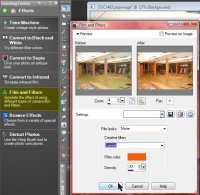 None of those features was appropriate for this image, but I selected Film and Filers and applied a "Sunset" (orange) filter to the image. That brought the wood tones back into line.
None of those features was appropriate for this image, but I selected Film and Filers and applied a "Sunset" (orange) filter to the image. That brought the wood tones back into line.
 The result is colors that are acceptably accurate and the workers in the background are now visible. This is a good solution, but the colors are a bit too saturated and vibrant. I'd like to back that off a bit.
The result is colors that are acceptably accurate and the workers in the background are now visible. This is a good solution, but the colors are a bit too saturated and vibrant. I'd like to back that off a bit.
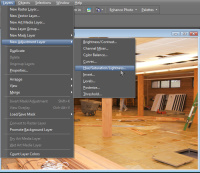 I decided to add an adjustment layer—one that will control hue, saturation, and lightness.
I decided to add an adjustment layer—one that will control hue, saturation, and lightness.
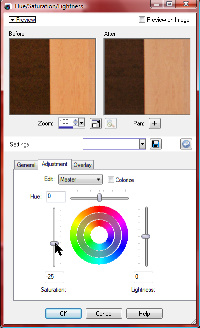 The saturation needed to be pulled back just a bit.
The saturation needed to be pulled back just a bit.
Once that was done, I was ready to save.
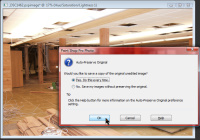 Saving .... This is where PSP X2's safety feature steps in and asks me if I want to preserve the original. Yes, I do.
Saving .... This is where PSP X2's safety feature steps in and asks me if I want to preserve the original. Yes, I do.
 The finished image has acceptable (if not perfect) color and the workers in the shadow area are visible.
The finished image has acceptable (if not perfect) color and the workers in the shadow area are visible.
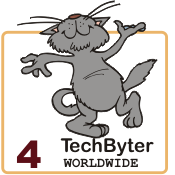 Bottom line: It's not Photoshop, but you may not need Photoshop.
Bottom line: It's not Photoshop, but you may not need Photoshop.
Corel Paint Shop Pro Photo X2 is exactly what you need if you don't have the budget (money and time) to buy and learn a complicated application such as Photoshop. PSP X2 makes it possible to fix the most common problems you'll encounter with digital images and to apply features that are amusing and fun.
For more information, visit Corel's Paint Shop Pro website.
Expired Domains as a Profit Center
TechByter.com is a domain name that is registered to me. I don't own it, but I do lease the name and pay an annual fee. If I would forget to renew it, I wouldn't be happy about what would happen next: Within hours somebody else would register the name and within a day visitors to TechByter.com would be served nothing but ads. This is known as drop-catching and domain tasting. The Internet Corporation for Assigned Names and Numbers (ICANN, although a more apt acronym would be "ICAN'T") all but encourages this practice and other abuses known as domain kiting and typo-squatting. If you have registered a domain name and you want to keep it, you need to protect it.
Domain tasting works because ICANN designed a system that assumes everyone is honest. Registrars can check out (almost like a library) domain names for a brief period at no cost. Had someone wanted to custom-write a system that would guarantee abuse, that is exactly the way it would be written. A registrar can load ads on domain names they're tasting and then make money on the pay-per-click ads. If the domain name turns out to be a money-maker, the registrar pays ICANN; if not, it releases the domain name.
Late last year, the Coalition Against Domain Name Abuse (CADNA) tracked expiring domains for one day, September 18. On that day, CADNA tracked 17,000 randomly selected org, com, and net domain names. The study noted that 100% of the com and net domains were immediately re-registered. More than 40% of the com and net domain names were dropped and added again during the course of the study. This is known as kiting, and this is another example of ICANN's shortsightedness: Domain names can be repeatedly tested and returned with no monetary penalty.
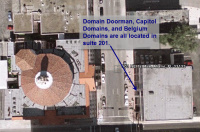 Nearly 90% of the com domains studied became pay-per-click sites. The study cited the primary abusers as Enom (15801 NE 24th St., Bellevue, Washington), Domain Doorman (501 NE 1st. Ave., Suite #201, Miami, Florida), Capitol Domains (501 NE 1st. Ave., Suite #201, Miami, Florida), and Belgium Domains (501 NE 1st. Ave., Suite #201, Miami, Florida). Yes, 3 of the 4 "primary abusers" as identified by CADNA are really the same operation located in a business building across the street from the Central Baptist Church. (Click the image for a larger view.)
Nearly 90% of the com domains studied became pay-per-click sites. The study cited the primary abusers as Enom (15801 NE 24th St., Bellevue, Washington), Domain Doorman (501 NE 1st. Ave., Suite #201, Miami, Florida), Capitol Domains (501 NE 1st. Ave., Suite #201, Miami, Florida), and Belgium Domains (501 NE 1st. Ave., Suite #201, Miami, Florida). Yes, 3 of the 4 "primary abusers" as identified by CADNA are really the same operation located in a business building across the street from the Central Baptist Church. (Click the image for a larger view.)
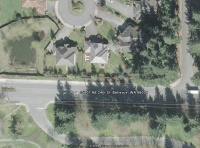 As for the Bellevue operation, at first glance, it seemed to be located in a tree on a vacant lot, but additional research revealed "Demand Entertainment, 15801 NE 24th Street, Bellevue, Washington" that seems to have something to do with Cracked magazine, the perennial also-ran to Mad and now a website that bills itself as "America's Only Humor & Video Site, Since 1958". Maybe we should tell them that the Internet wasn't around in 1958. What do Cracked and Demand Entertainment have to do with the registrar Enom? But, as usual, I digress.
As for the Bellevue operation, at first glance, it seemed to be located in a tree on a vacant lot, but additional research revealed "Demand Entertainment, 15801 NE 24th Street, Bellevue, Washington" that seems to have something to do with Cracked magazine, the perennial also-ran to Mad and now a website that bills itself as "America's Only Humor & Video Site, Since 1958". Maybe we should tell them that the Internet wasn't around in 1958. What do Cracked and Demand Entertainment have to do with the registrar Enom? But, as usual, I digress.
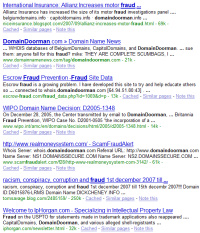 Additional data points:
Additional data points:
- Enom is described in this Rip-Off Report.
- Capitol Domains is listed in this Rip-Off Report.
- Belgium Domains is accused in this Rip-Off Report.
- Domain Doorman isn't the subject of a Rip-Off Report, but a Google search for +domaindoorman +fraud turns up more than 200 entries. >>>
CADNA has called on ICANN to change its ways.
According to the CADNA report, "CADNA maintains that abolishing the AGP is the safest and most effective solution," but the organization urges ICANN at least to "consider additional monetary disincentives associated with dropping a name during the AGP." The report suggests a "restocking fee" that's more than half of the domain registration fee. This would be an immediate deterrent to the negative aspects of domain tasting by penalizing those who register thousands of domains at a time, while having minimal impact on people who have made an honest mistake. CADNA also recommends an "excess deletion" fee to be charged when a registrar is clearly gaming the system.
CADNA says that it will data from its research available to the Generic Name Supporting Organization (GNSO, a division of ICANN). According to CADNA, a modest restocking fee would signal to government and the legitimate business community that ICANN takes the abuse seriously. "If ICANN does not take more decisive action, it will be clear that it has no interest in deterring bad actors from mining the domain space for personal gain at the expense of the greater Internet community."
All the more puzzling is this: ICANN clearly understands the problem as its Life Cycle of a Typical gTLD Domain Name chart clearly shows. Given that ICANN comprehends the problem and given the fact that this is not a new problem, the questions must be why nothing has been done to remedy the situation and why it takes pressure from an outside group to get any action.
The Bat 4: A First Look
The Bat has been my favorite e-mail application for years. I'd tell you how many, but I don't remember. I can tell you that I used PINE in the early days, and ELM. After that, it was Eudora until I discovered The Bat. This is not the right e-mail program for everyone, but it's been right for me for a long time because it's quick, it's adaptable, and it's secure. I may have to use Outlook (aka "LookOut!") at the office, but I wouldn't consider anything but The Bat at home. That's why I was more than a little nervous when RIT Labs (Moldova) released version 4 of the application.
I was worried that the new version would abandon the application's geek-friendly past and try to hug Outlook users. That hasn't been the case, but the developers have reached out to those who create HTML-coded e-mail.
Purist e-mail fanatics say that HTML has no place in e-mail. On an emotional level, I agree with that, but HTML is a part of e-mail. The most popular e-mail programs send HTML-coded e-mail by default. That may be a bad thing (or not) but the simple fact is that it is. ("It is what it is.") HTML mail is a reality. Individuals send HTML-coded mail. So to companies. What we need is an e-mail client that can deal with HTML mail without opening a gigantic security hole. The Bat may be that e-mail client.
With most e-mail programs, you have a choice of displaying images or not displaying them. DO NOT DISPLAY is secure; DISPLAY is not secure. It seems that e-mail programs should provide a finer granularity and that's exactly what The Bat does. You get to choose which domains will be allowed to display images in your e-mail. You may allow images from the Washington Post but forbid images from DoubleClick.
This has been one of the reasons I have avoided recommending The Bat to some people: To view HTML messages in the past, I had to launch a Web browser such as Firefox. Now I'm able to view HTML-coded messages in The Bat.
And guess what—upgrading from version 3.x of The Bat to version 4.0 is free. You may note that I specified version 4.0. That's because the upgrade from version 4.0 to version 4.1 will not be free. This is a remarkably clever way to move your user base from one major version to the next: Make the first upgrade free and then charge for the subsequent update.
I'll have a full review of the latest version of The Bat in a few weeks, but I suspect that it will be positive.
Nerdly News
End of the Road for HD-DVD
There are 2 high-definition formats for DVDs, HD-DVD and Blu-ray. Or, were. Blu-ray has won the battle. Wal-Mart has announced that it will drop HD-DVD gear in favor of Blu-ray. End of story.
Wal-Mart is nation's largest retailer and its 4000 US stores will drop HD-DVD players and discs. Earlier this week, Netflix said that it will carry only Blu-ray discs. Toshiba and Sony have been engaged in a high-stakes battle and it appears that Sony has won this one. Target and Blockbuster have also picked Blue-ray. Wal-Mart phase out HD-DVD discs and players by June. Stores will continue to sell standard definition movies and players. Sony's Blu-ray format also is backed by Disney, Sony Pictures, Twentieth Century Fox, MGM, and Warner Brothers.
Who's left in the HD-DVD camp? Toshiba, Paramount Pictures (and subsidiary DreamWorks), and Universal Pictures.
Creeps in Your Computer
The San Jose Mercury News has a worthwhile report on cybercrooks. They are out there and they're looking for information that's on your computer. " Somewhere in St. Petersburg, Russia's second city, a tiny start-up has struck Internet gold. Its dozen-odd employees are barely old enough to recall the demise of the Soviet Union, but industry analysts believe they're raking in well over $100 million a year from the world's largest banks, including Wells Fargo and Washington Mutual." If that frightens you, it should.
It's mainly a story of phishing and how sophisticated the attempts have become over the past few years. In the past, the attempts were amateurish and filled with spelling and grammar errors. Today they're far more clever and able to fool more than just the casual observer. " These attacks cost real people real money - individual Americans lost at least $200 million last year to online fraud - and that's just the people who took the time to report their misfortune to the FBI's Internet Crime Complaint Center. Those 200,000 cyberfraud victims said they were swindled out of an average of $724 - an amount small enough to discourage individual reporting, and to help keep Rock Phish relatively hidden."
Besides information lost to phishing, there's the danger of visiting (or being lured to) a website that can infect your computer if you're not running the latest security applications. "Some people are lured to visiting Web pages containing malware, either by inadvertently visiting infected sites or by clicking on an e-mailed link. There, a pixel-size frame, invisible to the user, stealthily installs code onto the computers of visitors lacking the latest Web browser security updates. Most users have no idea such a 'drive-by download' has taken place, even as these Trojan horses surreptitiously log their banking passwords or other private information."
For the rest of the story, see the Mercury News website.
The Weekly Podcast
Podcasts are usually in place no later than 9am (Eastern time) on the date of the program. The podcast that corresponds to this program is below. The most recent complete podcast is always located here.
Search this site: Looking for something you remember hearing about on TechByter Worldwide? Search me.
Subscribe to the newsletter: Subscribing to the podcast: I recommend Apple's Itunes for podcasts. Itunes will also install the latest version of QuickTime. The program is free. Need instructions?
Privacy Guarantee: I will not sell, rent, loan, auction, trade, or do anything else with your e-mail address. Period.
How the cat rating scale works.
Do you use a pop-up blocker? If so, please read this.
The author's image: It's that photo over at the right. This explains why TechByter Worldwide was never on television, doesn't it?
Feed the kitty: That's one of them on the left. Creating the information for each week's TechByter requires many hours of unpaid work. If you find the information helpful, please consider a contribution. (Think "NPR".)


